
What are audit procedures? Can you define the term with a single definition?
How are audit procedures relevant to your business?
How would you go about implementing audit procedures?
I will stop with the interrogation. I hope though, I have you thinking – I mean really thinking – about the term audit procedure. From my own experience, most people hear the term audit and have a general idea of what this is. But when it comes to defining the term or implementing audit procedures in a business, they struggle.
If you are one of those people, then luck is in your favor for having stumbled on this article. In this article, we at Process Street will take a look at audit procedures, define what they are and how they are implemented.
We then turn our attention to a specific type of audit procedure, namely, the internal audit. Finally, I will introduce to you Process Street’s new, game-changing feature: approvals.
This article is structured as below:
- Audit procedures: What are they?
- Audit procedures: The auditing process
- Audit procedures: Four different types of auditing opinion
- Internal audit: What is an internal audit
- Internal audit: The benefits internal audits bring to your business
- Internal audit: Disasters caused by internal audit neglect
- How you can use Process Street to conduct an internal audit for your business
- Process Street’s approvals feature and its use-value for internal audits
- A whistle-stop tour through Process Street’s free internal audit template resources
In the section A whistle-stop tour through Process Street’s free internal audit templates, you are presented with 19 free templates. I have listed these templates below so that you can plunge right in. Keep reading for more information on each template.
- Financial Audit Checklist
- Environmental Accounting Internal Audit
- Environmental Management Self Audit Checklist
- Management Systems Audit Checklist
- ISO 9001 and ISO 14001 Integrated Management System (IMS) Checklist
- ISO 9001:2015 Internal Audit Checklist for Quality Management Systems
- PPC Audit Checklist
- Google Analytics Audit
- Technical SEO Audit
- UX Audit
- ISO 27001 Information Security Management System (ISO27K ISMS) Audit Checklist
- SQL Server Audit Checklist
- Firewall Audit Checklist
- Network SecurityAudit Checklist
- Occupational Health and Safety (OHS) Audit Checklist
- Diversity Management Monthly Audit
- Hotel Sustainability Audit
- Laboratory Safety Procedure Audit
- Retail Store Audit Checklist
Audit procedures: What are they?
Audit procedures are the processes and methods that auditors perform to obtain audit evidence which enables them to make a conclusion on the set audit objective and express their opinion – Wiki Accounting, Audit procedures: Definition, Types, Example, List, Preparation
The term audit procedure encapsulate’s a very broad set of processes and methods. These are designed to determine the accuracy or safety of a given business operation, statement and/or record. Despite the broad range of procedures enveloped within the term audit procedure, they are all designed for the same end. That aim being, as per the definition above, to draw a conclusion on the set audit objective.
To clarify audit procedures further, we can break down the term into its two constituents: audit and procedure.
Audit definition
An audit is the process of evaluation or analysis of something to determine its accuracy or safety, or is the document that declares the result of such an analysis or evaluation – Your Dictionary, audit
An audit is a result, usually given in the form of a report, obtained from evaluating a particular business process or processes.
An interesting fact for you, the term audit is Latin derived from the word audire, which means to hear. With the prevalence of manual bookkeeping, auditors would hear accounts read out to them. Auditing was a case of being able to audire fraudulent and negligent behavior.
An audit can cover any business operation or subject matter. Commonly audited areas include:
- Financial
- Secretarial and compliance audit
- Internal controls
- Quality management
- Project management
- Water management
- Energy conservation
To produce an audit, you need a procedure, bringing us to the definition of our next constituent term (procedure).
Procedure definition
A set of actions that is the official or accepted way of doing something – Cambridge Dictionary, procedure
With the term audit procedure, we are referring to set procedures that are designed to produce an audit result. For successful audit completion, every step of the procedure must be performed to the T. That means removing any error and ensuring accuracy.
At Process Street, accuracy, efficiency, and productivity lie at the heart of our business offering. Process Street allows you to document and record set procedures and business processes. You can do this by using our superpowered checklists. To not jump the gun, for now, I will continue with my overview of audit procedures before I move onto Process Street and how we can help.
Already have a firm understanding of audit procedures? Why not scroll down to find out how Process Street can help you in the execution of your audit procedures for free.
Right, back to audit procedures.
Grasping a solid definition for audit procedure is a great starting point. This set foundation of understanding can be built on in the rest of this article. Next, we will consider – albeit briefly – the auditing process (because we love processes at Process Street).
Audit procedures: The auditing process ️
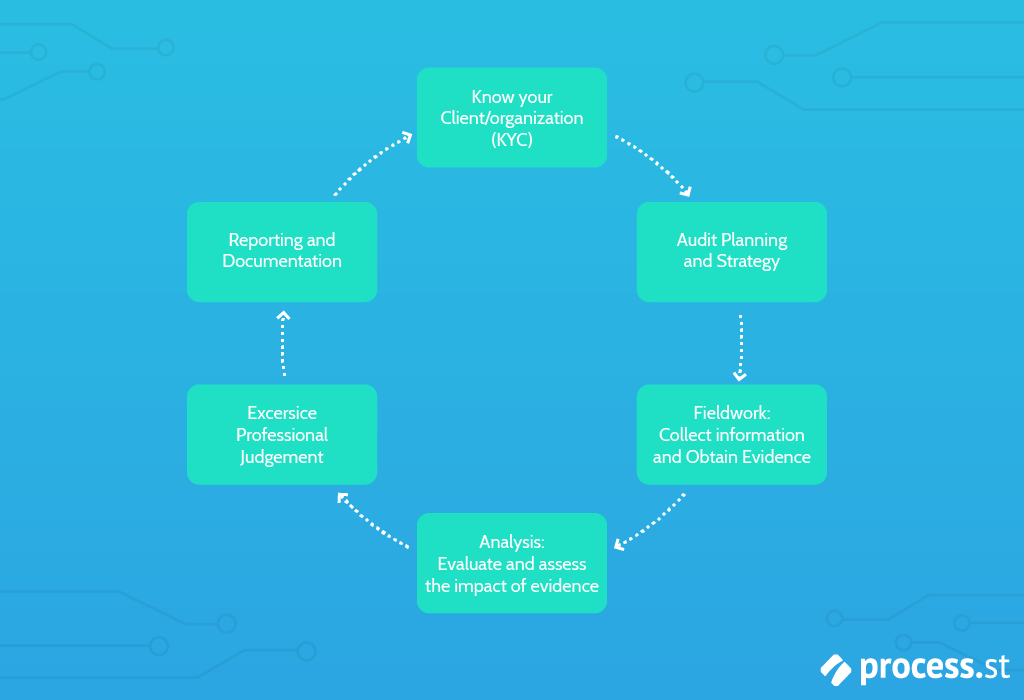
The individual carrying out an audit is called an auditor. Auditors may be internal to your business, as part of your organization. Alternatively, auditors can be external to your business, as part of a regulatory body or a governmental agency.
For successful completion of an audit, the auditor must follow the below six specific steps, as detailed by Chron.com:
#1 Auditing process: Know your client/organization
The given organization is notified of the upcoming audit. The auditor then works to get to know the organization. This step is more appropriate for an external auditor. Conducting client interviews is the simplest way to ensure step one’s completion. The auditor may also get written representations, or ask for access to previous audits and other documentation.
#2 Auditing process: Audit planning and strategy
On getting to know the company, the auditor will then plan their audit strategy. A risk workshop can be conducted during this stage, to find and identify possible problems. The audit plan is then drafted.
Need help with risk management? Check out our Ultimate Risk Management Guide: Everything You Need to Know with free to use templates to help you get started.
It is good to schedule an open meeting during this stage, inviting senior management and key administrative staff. The scope of the audit can be presented, and the time frame of the audit is determined. Relevant staff should be informed of possible interviews from the auditor.
#3 Auditing process: Fieldwork
The fieldwork part of the auditing process is usually where the main work begins. This part is about collecting information and evidence, which can be gathered by multiple means such as:
- Inspecting organizational records
- Inspecting organizational documents
- Inspecting both tangible and intangible assets. For example, does the organization hold the correct amount of inventory as stated?)
- Sourcing confirmation of organizational claims, often from a third party
- Observing business operations
- Conducting interviews and open meetings
#4 Auditing process: Analysis
Stage 4 takes all fieldwork information and compares this information against set standards. Compliance is tested using policies and procedures. Internal controls are evaluated to make sure they are adequate.
#5 Auditing process: Exercise professional judgment
Conclusions are made and a report draft is begun. Aspects of the report may include:
- mathematical errors
- posting problems
- false claim
- operational concerns
- organizational breaches from set standards
#6 Auditing process: Exercise professional judgment
Conclusions made will include commentary given by the auditor. This commentary may include recommended solutions for highlighted problems.
A closing meeting would solicit a response from management in terms of agreement or disagreement on the audit results. An action plan run by the auditor will address problems projected, to resolve all issues.
Finally, the audit report will be given one of four types of audit opinions, which we shall discuss next.
The four different types of audit opinion ️
In the final stage of the audit process, the audit report is branded with an audit opinion. You can think of different audit opinions as grades on a scale: with a pass at the lower end and fail at the upper end, and grades in-between. Although, admittingly, it does get a little more complicated than that.
There are four different types of audit opinions, which I have summarized below:
Disclaimer: these audit opinions are mostly associated with financial audits
- Unqualified: This is the gold star result. The result that every business strives for. An unqualified opinion means that all information is presented fairly, and is reliable.
- Qualified: A qualified opinion is a next level downgrade from the unqualified opinion. A qualified opinion means all information par one single issue, is presented as it should.
- Adverse opinion: An adverse opinion is the opposite of an unqualified opinion. This is your big fat F. Adverse opinion means that there are gross issues in need of addressing.
- Disclaimer: When a definite opinion is not possible, an auditor will give a disclaimer. The absence of information often results in a disclaimer opinion.
Speaking of disclaimers, you may have noticed that I added a disclaimer above the listed audit opinion types. This disclaimed that the above opinions are usually associated with financial audits.
Want to know more about financial audits? Keep a lookout for my upcoming post entirely focussed on this audit type.
You see, the auditing world is a bit of minefield in the sense that there is more the one type of audit. For example, as I mentioned under the header Audit definition, there are several different audit areas. The financial sector is just one of many business sectors that can be audited.
The classification of the audit type is dependent on the following factors:
- Type and level of assurance
- The objective
- The purpose
- The scope
- The use
However, this article will cover only one audit type, namely the internal audit.
Why?
An internal audit is one that is most relevant to you as a business owner or employee. It is this audit type that you have complete control over. It is the internal audit, that is absolutely in your hands.
Want to find out more regarding audits and the different types? Check out Wiki Accounting‘s Types of Audits: 14 Types of Audits and Level of Assurance.
For the remainder of this article on audit procedures, I will concentrate solely on the internal audit. You will find out the following:
- What an internal audit is
- Internal audits and the benefits they bring to your business
- Disasters caused by internal audit neglect
- How you can use Process Street to conduct an internal audit for your business
- A whistle-stop tour through Process Street’s free internal audit template resources
It is in this next section that you will be introduced to our state-of-the-art approvals feature. I will show you the feature’s considerable value for the running of your internal audit processes.
Internal audit: What is an internal audit?
An internal audit is a type of audit procedure that is conducted within an organization in a completely independent and objective manner, to ensure assurance of a given business operation to standards set by the organization, regulatory body or government.
The main features of an internal audit are:
- They are voluntary
- They are undertaken internally to your business, as part of your organization
Internal audits are broad. They can provide affirmation regarding compliance to set standards for different business operations. Once an internal audit is completed, the results are communicated to senior management and a committee board of directors.
There are six key activities centralizing internal audits. These are outlined by Accounting Simplified.com:
- Monitoring internal controls effectiveness and suggesting areas for improvement
- Instances of fraud and theft are investigated
- Compliance to laws and regulations is monitored
- Financial and operating information is reviewed and verified
- Risk management policies and procedures are evaluated
- Effectiveness, efficiency and the economy of operations and processes are examined
Internal Audit: The benefits internal audits bring to your business
So far, we have built a good stem of knowledge regarding audit procedures. From this, we have branched out, considering the internal audit, defining what the internal audit is. Why though, do we need to use both time and energy to diverge down this internal audit offshoot?
Our question: why use precious business time and energy to conduct an internal audit?
Whenever I look to answer the why, I question, what are the benefits? In this sense, what benefits will an internal audit bring to your business?
Luckily for you, I have summarized five fundamental benefits internal audits bring below, as defined by Partners:
- Measure practices and processes against proposed procedures to make corrections
- Reduce the risks of data breaches and other cybersecurity concerns
- Protect your internal network
- Enable you to stay up to date on governmental regulations to maintain compliance
- Monitor mobile technology security and efficiency
Internal audits are designed for the continual improvement of your business operations, The aim is to identify system weaknesses, and have plentiful opportunities and time to correct those weaknesses.
Considering the above benefits internal audits can bring to your business should be enough to spur you into action.
However, if you are still not convinced, I recommend that you continue reading. In this next part, we will find out what can happen when regulations and set standards go awry.
Internal audit: Disasters caused by internal audit neglect
Standards are set to manage risk and ensure the clean running of business operations. If you are not checking your procedures, how do you know they aider to the standards set?
In this next section, I will give examples of when business operations and procedures neglect set standards. The aim is to drill down the importance of the internal audit. I will then give an example of correct internal audit use, for contrast with the given examples of internal audit neglect.
The U.S financial crash caused by regulation neglect?

Something big happened in 2008, shocking our economic world to a near-enough halt. The 2008 U.S. financial crisis has been described as the worst economic disaster since the great depression of 1929. Since there have been numerous studies and points of view on the cause or causes of the crisis.
One potential cause was put forward by the Financial Crises Inquiry Commission. In the commission’s own words – regarding the financial crisis cause:
The Commission concluded that this crisis was avoidable. It found widespread failures in financial regulation; dramatic breakdowns in corporate governance; excessive borrowing and risk-taking by households and Wall-Street; policymakers who were ill-prepared for the crises; and systemic breaches in accountability and ethics at all levels – The Financial Crises Inquiry Commision (FCIC), Conclusions
As concluded by the FCIC, financial regulatory breaches could have played a key part in the financial crisis. Regular, thorough and extensive internal financial audits are designed to prevent such breakdowns, preventing the associated negative repercussions.
According to a study by the U.S. Government Accountability Office, the financial crises cost the U.S Economy ~$22 trillion. This figure sums up my point: neglecting set standards can have detrimental, costly impacts down the road. Internal audits are there to make sure you keep on track.
London’s Grenfall tower caused by regulation neglect?

As a past London dweller, the Grenfell tower disaster really struck a chord. I had been a student in London for the past four years, and so knew of Grenfell tower and the surrounding area before the building crumbled to ashes.
On the 14th of September 2017, just before 01:00, a fire broke out in the 4th-floor kitchen of the 23 story tower block, located in West Kensington, London. It took only minutes for the fire to spread, racing up the exterior of the building. In as little as 2 hours, the majority of the upper floors were ablaze. Seventy-two people died from the catastrophe. How did this happen?
Grenfell Tower had a stay-put fire policy. The building had been designed to contain a fire to a single flat. However, as the residents sat tight, the fire sparked out of control, pumping thick poisonous smoke up the stairwell. Clearly, there had been a substantial failure to the policy.
This failure was due to regulatory breaches during the tower’s refurbishment. With hindsight, particular attention was paid to breaches in building cladding. It was this cladding that caused the fire to spread so rapidly resulting in the death of 72 people.
In this instance, the implementation of a strict and effective internal audit would have controlled fire risk. For one, by ensuring appropriate cladding fixtures.
Speaking to my colleague about this incident, who was also living in London at the time, Thom James Carter summed up my point very nicely:
I remember seeing the smoke from across London. Grenfell tower highlights why businesses/organizations should always, always adhere to regulations, undergo regular audits, and not skip corners – Thom James Carter
Correct use of an internal audit

In 2017 I landed a job at an environmental science laboratory. The laboratory tested samples of water and soil, to check the contamination levels of common pollutants. This included testing for pesticides, metals, and hydrocarbons.
The laboratory is an accredited laboratory, meaning that all tests and procedures have to be carried out as per set standards. This means no deviation. No errors. No inaccuracies. Failure to continue as per set standards will result in accreditation loss. Laboratory customers only wanted accreditated results, as only accreditated results are recognized.
The laboratory often carried out internal audit checks, making sure procedures did not lax away from set standards. Results from one internal audit meant accreditation from a sole metal test had to be removed. Without accreditation for this single metal test, the laboratory lost customers. However, this was only a short-term adversity.
The procedure was soon set right as per the required standards. In the long-term, identifying the regulation breach internally meant the laboratory avoided fines and reputation loss that would have eventually hit hard with a guaranteed but unexpected, external audit.
Want to know more about external audits? Check out Humentum‘s External Audit post.
How you can use Process Street to conduct an internal audit for your business
So far we have:
- Defined what audit procedures are
- Obtained a basic understanding of the audit procedure processes
- Briefly considered different audit opinions
- Explained the broad range of audit types
- Focussed specifically on internal audits, defining what an internal audit is
- Explained the advantages internal audits bring to a business
- Looked at disasters caused by internal audit neglect
- Looked at an example of an internal audit done right
In this next part of the article, we turn our attention to Process Street, and how Process Street can help you with your own internal audit.
You see, as we mentioned before, audit procedures – which encompasses the internal audit – are a set of standard operations, that should be carried out precisely, accurately, efficiently and effectively. Any deviation from these set standards will lose you your unqualified – or equivalent – audit opinion, and we don’t want that.
Process Street has been created to help business owners such as yourselves. We look at every business operation, and think ‘what can we do to help?
When it comes to audits, we understand how daunting they seem. Especially with the added pressure of making sure every step is performed to the T. That is why Process Street’s content creation team has been working hard to create a broad range of internal audit checklists, free and ready to use right away.
For those of you that are unfamiliar with Process Street and our offerings, check out our Monthly Webinar: An Introduction to Process Street below.
Why are our checklists superpowered?
Well checklists, in general, are an awesome tool. Strength comes with simplicity when taking the checklist approach. From using this simple tool, you can:
- Save time
- Delegate more easily
- Be more effective
- Increase consistency
- Create simplicity to otherwise complex processes
- Increases efficiency
- Enhance collaboration
- Increase productivity
As you can tell, checklists bring many advantages. However, at Process Street we wanted to go one step further. We wanted to make our checklists superpowered . We did this by adding the following features:
- Stop tasks to ensure task order
- Dynamic due dates, so no deadline is missed
- Conditional logic, creating a dynamic template that caters to your needs
- Role assignment, to ease task delegation within your team
There is one feature though that I want to bring to the forefront. That is Process Street’s new approvals feature .
Process Street’s approvals feature and its use-value for internal audits ⚡
Process Street’s approvals feature has been designed to streamline any processes that need manager sign-off, from single instances to multi-step or sequential approvals. This feature has been designed to save you heaps of time, preventing setbacks and lengthy delays. Our new approvals feature is all about getting you your acceptions and rejections on time.
Internal audit results have to be accepted by upper management, and often by a committee board of directors. With our approvals feature, this can be done at a click of a button.
To add an approval task, simply click on the approvals button. This is located on the bottom of the left-hand bar within the template editor, where tasks and task headers can be added.
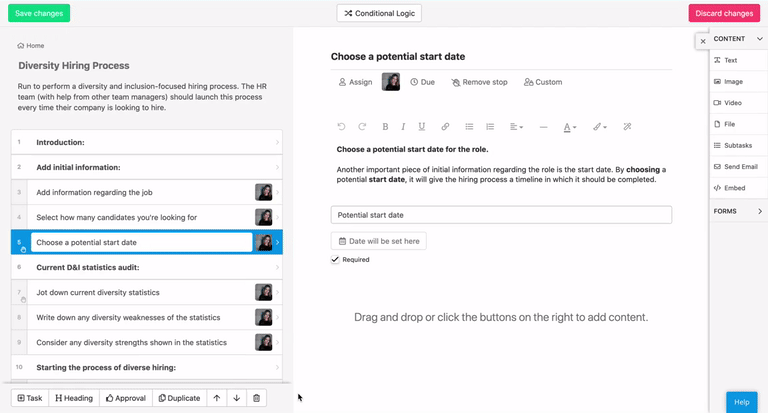
Once you have added the tasks, within your internal audit, that are subject to approval, then they can be assessed. The assigned approver can easily open the checklist, see the information from the tasks, then either approve or reject, or reject with a comment.
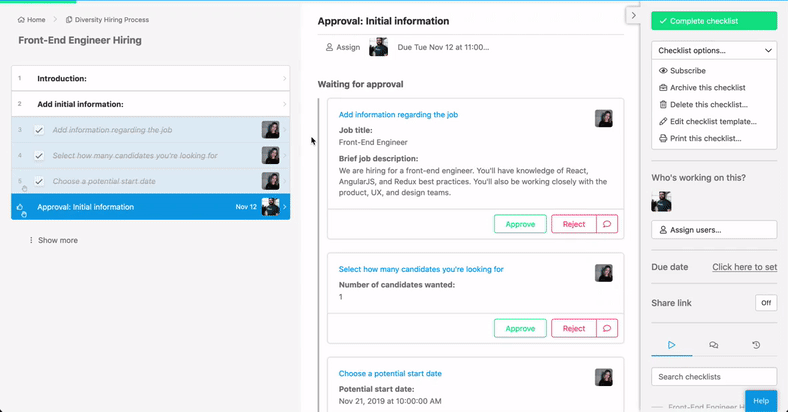
Want to know more about this game-changing feature? Read our Approvals: How to Streamline Decision-Making in Process Street article.
You should now have more of an idea about Process Street and what we offer. It is time for us to go on our whistle-stop tour of Process Street’s very own internal audit procedure templates, free and ready for you to jump right in.
I have split each audit template per relevant business area. Remember audit procedure is a broad term that spans across multiple business disciplines. You can decide to use any one of our internal audit checklists. You can also edit our templates to increase checklist relevance to you and your business, or create your own from scratch.
You may have noticed I have been flitting between the two terms, checklists and templates. To iron out any confusion, I recommend that you watch the below video which explains the difference in the context of Process Street.
A whistle-stop tour through Process Street’s free internal audit template resources
Below I have compiled an extensive list of Process Street’s internal audit procedures, which are free and ready to use. As mentioned before, I have categorized each audit procedure into the relevant business area. At the end of this list, I present audits that are specific to a particular business area and explain how you can create your own unique audit checklist.
Audit procedures: Internal financial audits
When I think of the term audit I immediately envisage financial audit procedures. This isn’t surprising, as auditing operations originated from systematic checks on public accounts. These date way back into the 18th century. As these internal financial checks developed, so did auditing as a discipline. Auditing grew to encompass a greater range of business divisions.
It is at Financial Audits where we start our whistle-stop tour of Process Street’s internal audit library. This seems fitting to audit procedures history.
Financial Audit Checklist
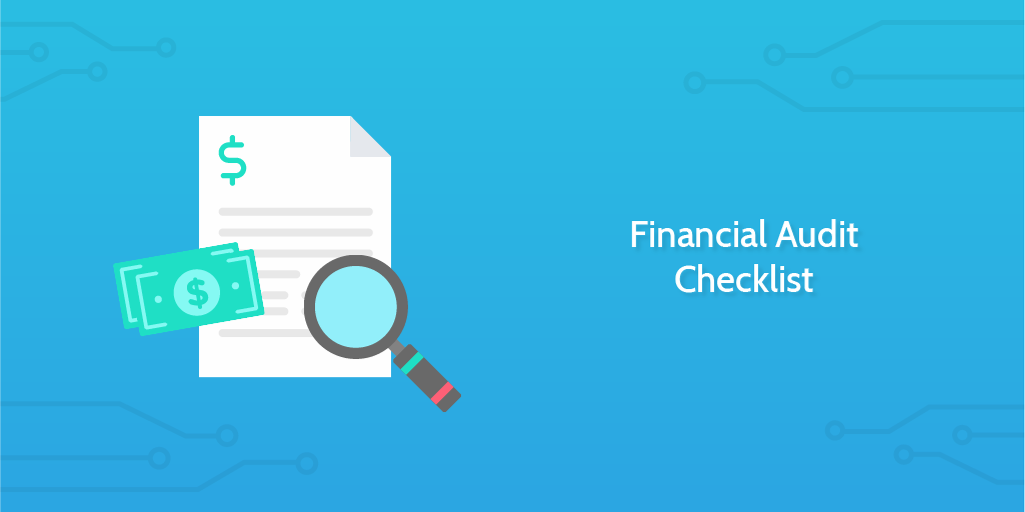
With regular internal financial audits, you can:
- Maintain consistency
- Help insurance
- Determine profit or loss
- Assist in determining the total tax
- Help in fraud detection
- Help prepare future plans
Start your internal financial auditing procedures with our Financial Audit Checklist. Use this checklist to evaluate your organization’s financial reports and reporting processes in an objective and independent manner.
Click here to access our Financial Audit Checklist
Audit procedures: Internal environmental audits
Environmental audits assess business practices with the aim to minimize the harm caused to the environment. Environmental audits are an environmental management tool. However, depending on the types of standards and the focus of the audit, there are different types of environmental audits.
Environmental Accounting

I firstly present to you Process Street’s Environmental Accounting Internal Audit.
Our Environmental Accounting Internal Audit checklist is a guide to support your small business accounting processes for the attainment and retainment of a sustainability focus.
Click here to access our Environmental Accounting Internal Audit
ISO 14001 Environmental Management Self Audit Checklist
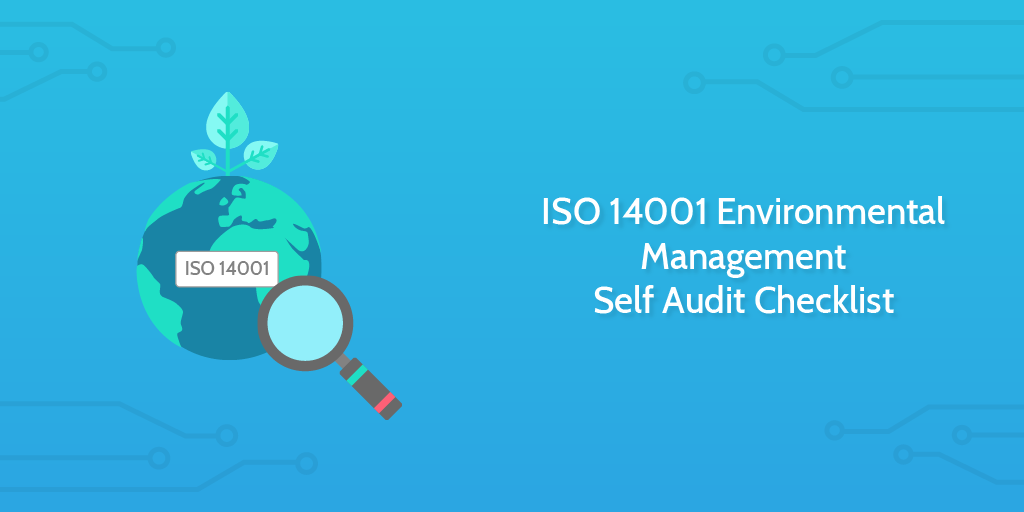
The International Organization for Standardization (ISO) develops and publishes international standards for set business processes. These standards are arranged in families. Here we are considering the ISO 14000 family, as introduced in the video below.
The ISO 14000 set of standards improve companies environmental responsibilities. Our ISO 14001 Environmental Management Self Audit Checklist should be run as you perform an internal audit on an environmental management system (EMS), against the requirements set out in ISO 14001:2015.
Click here to assess the ISO 14001 Environmental Management Self Audit Checklist
Audit procedures: Internal management auditing
Management auditing looks at an organization’s managerial aspects of a business. The aim is to improve the efficiency and performance of these operations. As often is the case, non-financial data is considered to examine the decisions and actions of management.
ISO 19011 Management Systems Audit Checklist
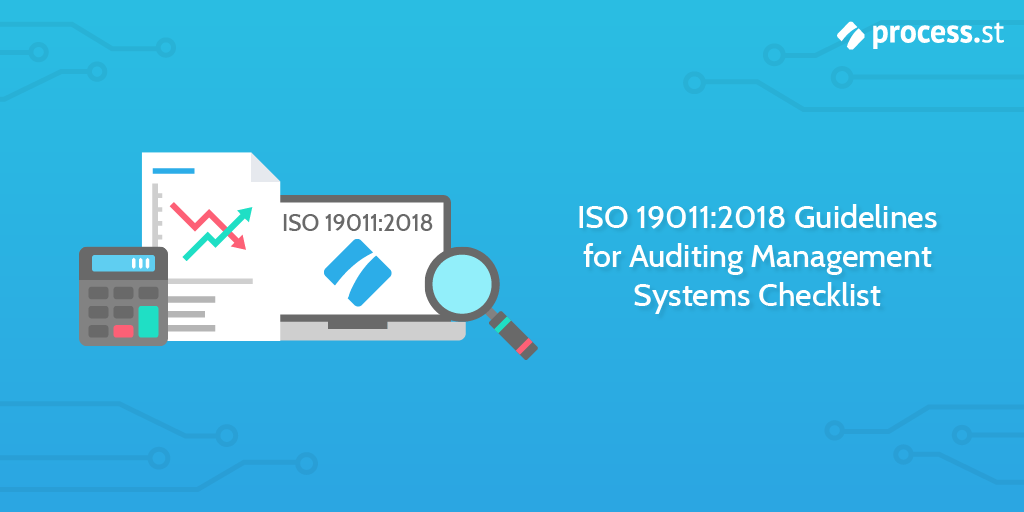
The ISO 9000 is a family of quality management system standards. They have been designed to help organizations construct, maintain and continuously improve their quality management systems. ISO 9000 is international standards used for quality management and quality assurance.
Here we have our ISO 19011 Management Systems Audit Checklist created from the guidelines set out in ISO 29011:2018 for auditing your management systems.
Click here to assess our ISO 19011 Management Systems Audit Checklist
ISO 9001 and ISO 14001 Integrated Management System (IMS) Checklist
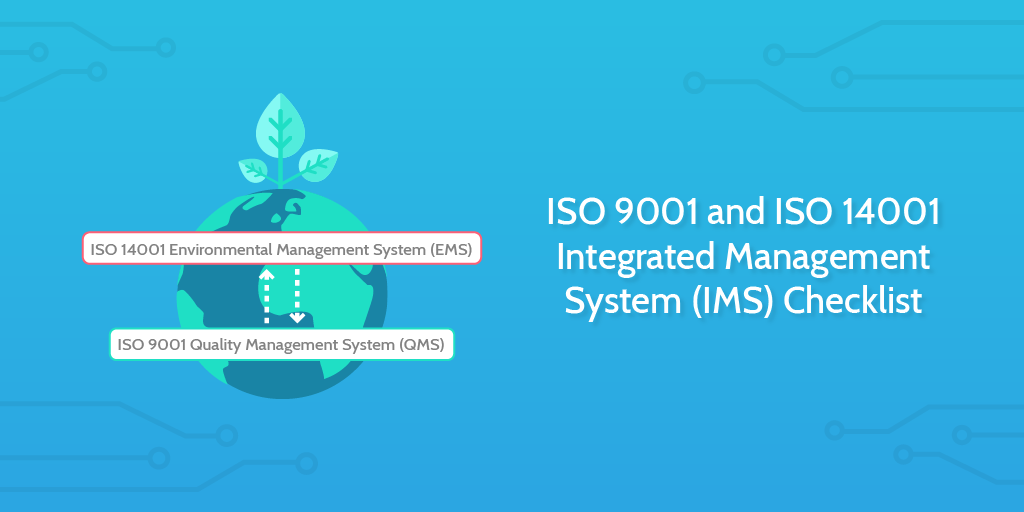
This ISO 9001 and ISO 14001 Integrated Management System (IMS) Checklist integrates your ISO 9001 internal audit (which has a purely managerial focus) with your ISO 14001 internal audit (which has an environmental focus). Integrating the two procedures provides a single unified integrated management strategy. This strategy has a sustainable focus. For sustained long-term success, environmental health needs to be considered in harmony with your business operations. To find out more read our How You Can Create a Sustainable Business For Long-Term Success.
Click here to access our ISO 9001 and ISO 14001 Integrated Management System (IMS) Checklist
ISO 9001 Audit Checklist for Quality Management Systems
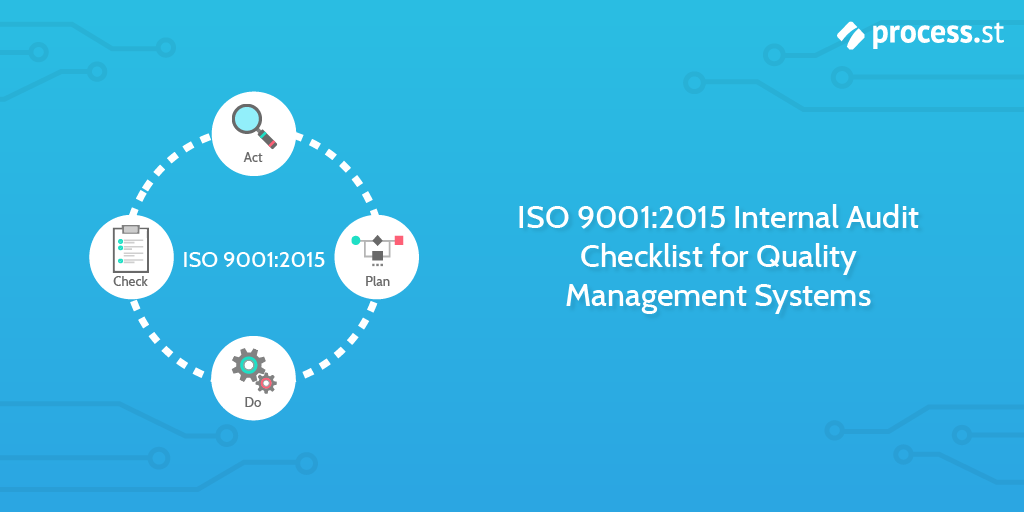
Our ISO 9001 Internal Audit Checklist for Quality Management Systems template lays out the step-by-step process for you to perform an internal audit on your quality management system (QMS) against ISO 9001:2015 requirements.
Click here to access our IS0 9001 Internal Audit checklist for Quality Management Systems
Audit procedures: Internal marketing audits
As the marketing industry shifts with rapid-paced movement, it can be hard for your business to keep up. Continual changes in technology, spending, and consumer behavior all alter the strength of your marketing processes. It is important that you keep reviewing your marketing operations. You need to make sure that they are in tune with the business landscape at any given time. Performing regular internal marketing audits means you can do just this.
Internal marketing audits comprehensively and systematically evaluate with interpretation the business marketing environment against your goals and objectives. The aim is to determine problem areas and spot opportunities.
PPC Audit Checklist

Nobody counts the number of ads you run; they just count the impression you make – Bill Bernbach, HubSpot 23 Quotes From Bill Bernbach on Advertising and Creativity
As mentioned by Bill Bernbach, you want your marketing procedures to make an impact. The pay-per-click model means you pay a fee each time a consumer clicks on a given add. You are essentially buying visits. Given that brand awareness is increased by 80% through paid Google ads, you can see why PPC marketing is attractive.
Our PPC Audit Checklist is an in-depth framework covering core focus areas of your PPC marketing strategy. Using this internal audit, you are guided through goal setting, optimization of campaign sets, budget allocation, keyword review, and proper ad extension choice.
Click here to access our PPC Audit Checklist
Google Analytics Audit

Google Analytics is part of Google’s Marketing Platform, providing free tools that help you analyze data for your business in one place. Like any tool, you have to know how to use Google Analytics properly, ensuring correct configuration so as to not receive bad data.
Our Google Analytics Audit comes in with necessity, to help make sure you receive only good data from Google Analytics. Performing regular internal audits assures your data is complete, up-to-date and configured correctly. This Google Analytics Audit has been designed to be run externally by a qualified auditor. However, you can edit the template so as to make it more relevant as an internal audit,
Click here to access our Google Analytics Audit
Technical SEO Audit

We live in a digital age meaning consumers spend much of their time sourcing products and services online. This is a behavior that is only increasing, with 97% of consumers using the internet to search for local businesses. This means you need an online presence, and you need your online presence to stand out.
Search Engine Optimization (SEO) is a marketing method to boost your website’s visibility online to users of a web search engine. You can use our Technical SEO Audit to audit your domain and generate a comprehensive report on the current status of your website. From this audit, you will find out what is working and what is not in terms of your SEO strategy. With this internal audit, you can improve upon your SEO strategy, and ultimately your online visibility.
Click here to access sour Technical SEO Audit
UX Audit

SEO is designed to get users to visit your website. However, you also want visiting users to one: stay on your website, and two: obtain a clear idea of your product or service offering with ease. This ultimately comes down to optimizing the user experience.
You can use our UX Audit to review your website’s user experience. This audit scrutinizes the customer journey through your website, providing an opportunity for tremendous improvement of conversion and engagement metrics.
Click here to access our UX Audit
Audit procedures: Internal information technology audits
The infrastructure, policies, and operation of your information technology systems can be examined with an internal information technology audit. By auditing your IT business operation, you can determine the effectiveness of your IT controls and ensure data integrity.
ISO 27001 Information Security Management System (ISO27k ISMS) Audit Checklist
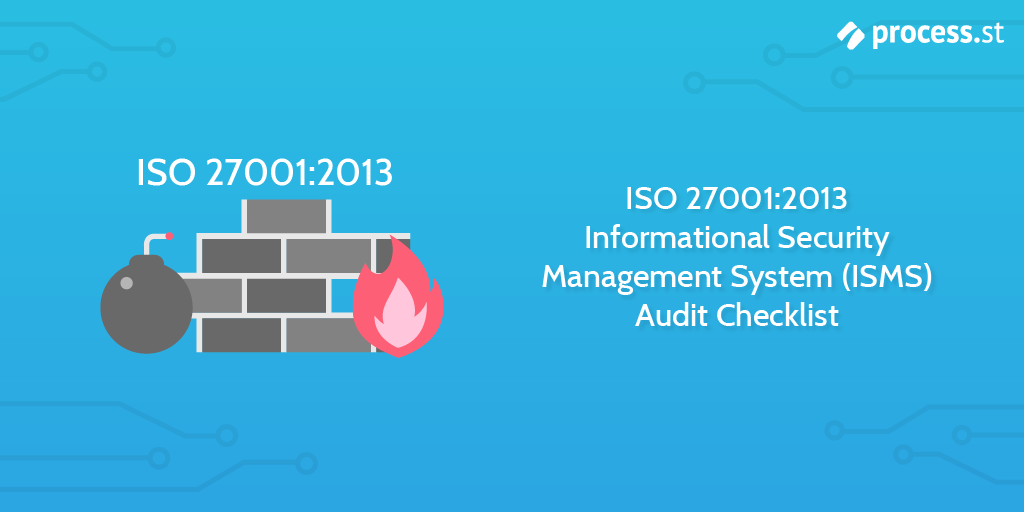
The ISO 27000-series of standards comprises information security standards that detail the best practices and recommendations for the management of information risks. The ISO 27000 series is broad in scope, covering privacy, confidentiality, and IT/technical/cybersecurity issues.
Process Street’s ISO 27001 Information Security Management System (ISO27K ISMS) Audit Checklist is designed for you to easily perform an internal audit on your organization’s information security management systems (ISMS), as per the ISO 27001:2013 requirements.
SQL Server Audit Checklist
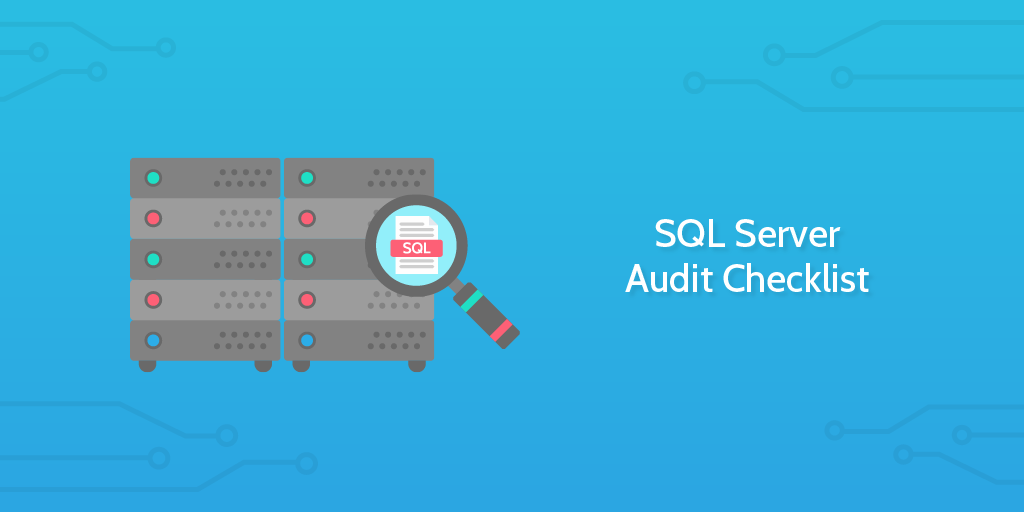
As standards for SQL Server logging compliance tighten, due to data security acts such as HIPAA and PCI DSS, it is becoming increasingly difficult to stay on top of your SQL Server Audit. This is why Process Street has created to SQL Server Audit Checklist, to ease the process of carrying out an SQL Server Audit.
Click here to access our SQL Servier Audit Checklist
Firewall Audit Checklist
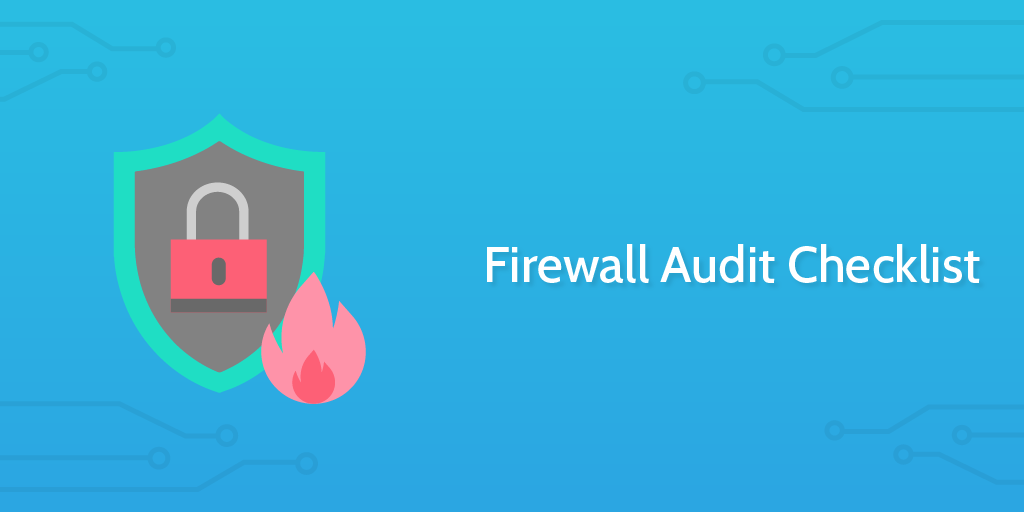
So you want to prevent unauthorized access to and from your private network. Implementation of a firewall barrier acts as a shield, enhancing the security of your devices connected to your network. The question is, how secure is your shield?
Our Firewall Audit Checklist provides you with a step-by-step guide, to scrutinize your firewall shield. This internal audit reviews firewall protection with the intention of optimizing security and performance.
Click here to access our Firewall Audit Checklist
Network Security Audit Checklist
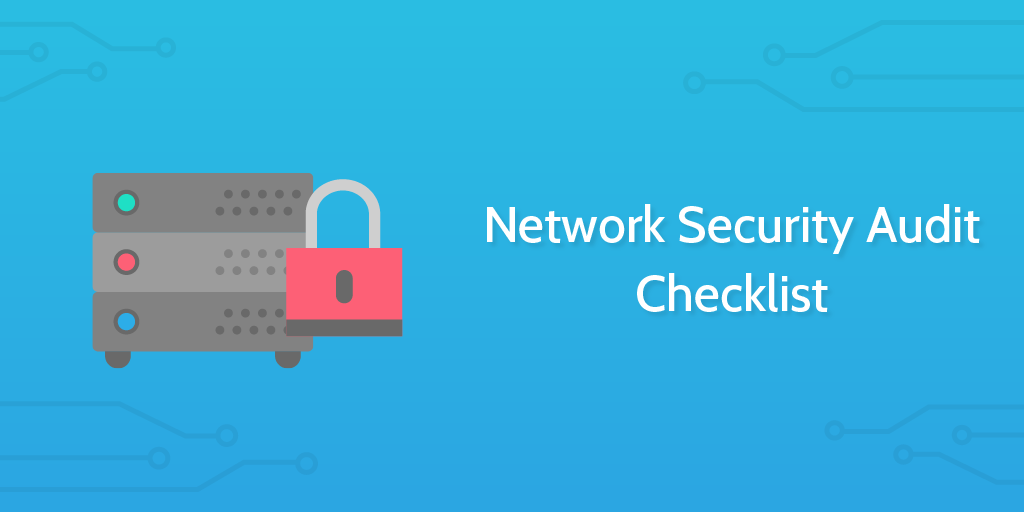
Our Network Security Audit Checklist is designed for you to perform effective checks on security measures within your infrastructure. Ths audit checklist is designed to be used by large organizations, to perform in-house audits as part of an on-going risk assessment.
Click here to access our Network Security Audit Checklist
Audit procedures: Internal workplace audit
An internal workplace audit looks into the policies and procedures of a business that are associated with human resources and other areas of the organization. The purpose is to ensure that a given employer is compliance with laws and regulations. In addition to maintaining a happy and healthy working environment.
ISO 45001 Occupational Health and Safety (OHS) Audit Checklist
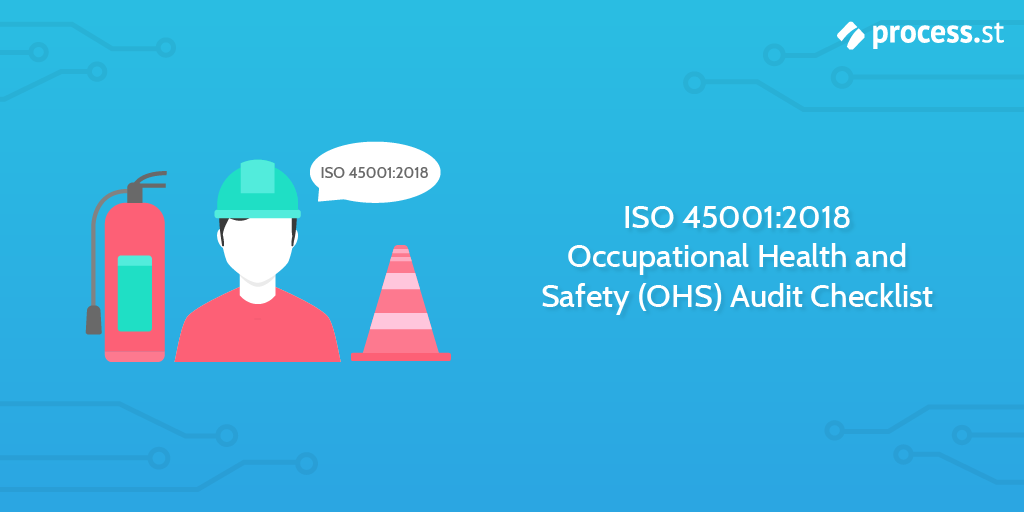
The IS0 45000 series has been set up to provide internationally recognized standards for health and safety systems within an organization. The series has two specifications:
- Requirements for effective organizational health and safety management systems
- The practical implementation of the set guidelines.
Process Street’s ISO 45001 Occupational Health and Safety (OHS) Audit Checklist can be run to perform an internal audit on an organization’s occupational health and safety (OHS) management system, against the ISO 45001:2018 requirements.
Click here to access our ISO 45001 Occupational Health and Safety (OHS) Audit Checklist
Diversity Management Monthly Audit

Having a broad and diverse workforce can benefit your company culture. These benefits transcend resulting in high productivity and profitability. You can use our Diversity Management Monthly Audit checklist to manage your diversity operation at the end of every month.
Click here to access our Diversity Management Monthly Audit checklist
Audit procedures: Industry-specific audits
The audits presented above are applicable to most industries and businesses. However, some business operations and procedures are more unique. This does not mean they should escape internal checks and audits. It is important to make sure you have internal measures for all your business processes, so they are carried out as required. This could mean the creation of very niche internal audits.
Below are some examples of Process Street’s industry-specific internal audit checklists. These will give you an idea of what you can create for your niche processes.
Hotel Sustainability Audit

Climate change, biodiversity loss, habitat destruction, overexploitation are to name of the pressures humans are placing on our environment. If you have read my previous article How You Can Create a Sustainable Business For Long-Term Success, you will understand how environmental health, directly and indirectly, impacts our society and ultimately our economy on a number of scales.
Recognizing the enveloped-type relationship between economies, society, and the environment has spurred businesses across all industries to look at how they can make their operations more sustainable. Using internal audits such as the ISO 4001 Environmental Management Self Audit Checklist can help you reach your sustainability goals. Sometimes though, it is good to delve into industry-specific details. You can do this by implementing a more specialized audit to assess how sustainable your business operations are.
Here we have our Hotel Sustainability Audit giving you an example of such an industry-specific audit.
Click here to access our Hotel Sustainability Audit
Laboratory Safety Procedure Audit

The Health and Safety Executive estimates that there are 1.2 million cases of ill health, caused by, or made worse from work. This has resulted in ~22.3 million lost working days. These are big numbers, all of which can be avoided with an effective health and safety strategy.
An internal audit offers a thorough quality control check of your business operations. In terms of health and safety, this means spotting potential risks before they impact your processes.
Our Laboratory Safety Procedure Audit exemplifies how you can set up your own specific internal health and safety audit.
Click here to access our Laboratory Safety Procedure Audit
Store Audit Checklist

Internal audits are useful for the general management of your business procedures. There will be many business operations that are niche for your business. This means key steps and processes may not be covered in more general internal management audits.
Just like our Store Audit Checklist, you can adopt a more unique approach for your internal management audits.
Click here to access the Store Audit Checklist
You can create your very own internal audit checks, just like the ones above, using Process Street. Check out our video below, which runs through the basics of how you can do this via creating a template from scratch.
Use Process Street as a helping hand to guide you through your auditing processes
I now draw this article to a close. In this article we have covered:
- A definition of the term audit procedure and an explanation of what audit procedures are
- A basic understanding of the audit procedure processes
- A brief consideration of the different audit opinions
- An explanation of the broad range of audit types
- A focused view on internal audits, defining what an internal audit is
- An explanation of the advantages internal audits bring to a business
- A look into two disasters caused by internal audit neglect
- A look into an example of an internal audit done right
- An explanation of how you can use Process Street for your internal audit processes
- A presentation of Process Street’s new approvals feature, and its use-value for internal audits
- A whistle-stop tour through Process Street’s free internal audit template resources
Understanding audit procedures relevant to your business safeguard’s business processes. This is important for the successful, smooth running of business operations.
There are many different types of audit procedures out there, however, the internal audit procedure is one that is entirely in your hands. Despite how daunting audit procedures initially seem, you are not on your own. You can use Process Street as a helping hand. We can guide you through your internal checks making sure your business operations abide by the required set standards.
Are there any audit procedures you would like resources for with not yet covered by Process Street? Please let us know in the comments section below, who knows, you may even be mentioned in one of our upcoming articles.







 Workflows
Workflows Forms
Forms Data Sets
Data Sets Pages
Pages Process AI
Process AI Automations
Automations Analytics
Analytics Apps
Apps Integrations
Integrations
 Property management
Property management
 Customer management
Customer management
 Human resources
Human resources
 Information technology
Information technology



Jane Courtnell
Hi there, I am a Junior Content Writer at Process Street. I graduated in Biology, specializing in Environmental Science at Imperial College London. During my degree, I developed an enthusiasm for writing to communicate environmental issues. I continued my studies at Imperial College's Business School, and with this, my writing progressed looking at sustainability in a business sense. When I am not writing I enjoy being in the mountains, running and rock climbing. Follow me at @JaneCourtnell.